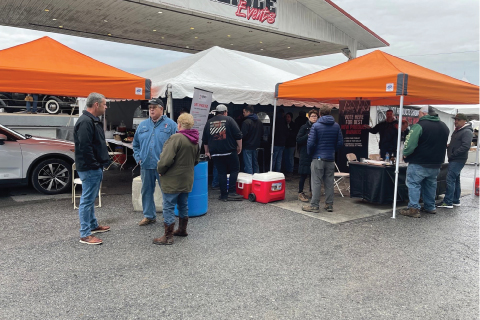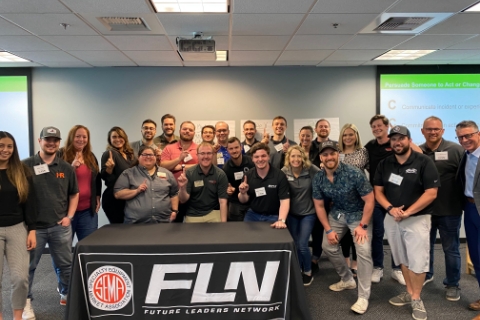SEMA Member News July 2020
By Ellen McKoy
SEMA’s Tech Transfer Program Streamlines New-Product Development
Caption: SEMA Garage OEM CAD data from a session.
Caption: SEMA Garage live session vehicle scan.
SEMA-member accessory and performance-parts manufacturers nowadays have access to an array of tools to aid in the design and development of new products. They range from OEM CAD data and 3-D scanning and printing to vehicle measuring sessions and more. But that has not always been the case.
At one time, manufacturers were hard pressed to gain early access to new vehicles or OEM technical data. They most often had to rely on reverse engineering. To complicate matters, companies frequently had to wait after new models were introduced before they could get their hands on them long enough to even prototype parts.
Challenged by the inability to debut new products to coincide with new-vehicle rollouts meant losing a valuable marketing advantage. The lack of access sometimes also led to deficiencies in product quality and fit and finish, and the likelihood that automakers would be amenable to data sharing was considered highly improbable.
But with the launch of the SEMA OEM Roundtable Tech Talks in 1993, things began to change. The forum was open exclusively to member manufacturers. Held annually with Detroit automakers for more than a decade, the program gave members a firsthand, long-lead look at new models plus advance access to vehicle specs and marketing data.
One of the earliest tools was aimed at helping body builders with product development. The “Ford Body Builder” books, as they were known, were chock-full of drawn-to-scale vehicle schematics and line drawings. In 1999, with support from Jacques Nasser, then Ford CEO and president, the books morphed into 2-D blueprint files, ultimately laying the groundwork for SEMA’s Tech Transfer program.
“That’s how it all came to fruition,” recalled Mike Spagnola, SEMA vice president of OEM relations and product development. “When we started Tech Transfer, it was only 2-D files. It started with Jacques Nasser agreeing with SEMA to be part of the program. Shortly after that, General Motors agreed to do the same, and shortly after that, Chrysler came on board.”
Adapting to Technology
The program has continued to evolve. The 2-D files have been replaced by 3-D CAD data from Ford, Lincoln, General Motors/Chevrolet, Chrysler, Dodge, Ram, Jeep, Fiat and Scion. While there are now thousands of CAD files in the database, Spagnola noted that it not only took time to amass the files but also for member companies to master the technology.
“We first started to get some of the actual CAD files in the late ’90s and early ’00s,” he said. “But it was hard to transfer the data because [few companies] had the computer capacity or the computer knowledge to use it. CAD data was definitely ahead of the market, but members have learned to adapt and are using better technology for developing products.
“The early adapters were the suspension and engine-development guys and truck-accessory companies. It took a little longer for the styling industry to adapt and translate CAD into something that has dimension versus a mechanical item, but we see that taking off now.”
In fact, the program has experienced a growth spurt. Besides OEM CAD files, there is a 3-D scan library of other vehicles created using SEMA Garage’s Faro 3-D scanner. There are 506 scan files consisting of 26 makes and 94 models, including Toyotas, Nissans and off-road side-by-sides such as Polaris. Additionally, the program hosts data for international vehicles that include the Nissan Patrol, Toyota HiLux and right-hand-drive Ford Ranger. Just as significantly, the number of participating member companies has skyrocketed.
“When I got to SEMA six years ago, the number of members using Tech Transfer was fairly low,” Spagnola said. “Today, we have six times more members using Tech Transfer. I don’t know of a SEMA-member manufacturer that couldn’t take advantage of the Tech Transfer program.”
Bringing Better-Made, Quality Products to Market
Henry Vasquez, director of product development at Rolling Big Power (RBP), and Kevin Sanchez, owner of K Designs, are true believers. In their experience, Tech Transfer has provided a critical edge in bringing superior-quality products to market faster and more cost effectively. From Vasquez’s perspective, Tech Transfer is beneficial in multiple ways.
“It’s all about new-product development,” he said. “We make wheels, so part of our use of the data is to make sure that the (OEM) brake packages still fit within the profile of our wheels and allow us to make adjustments as new trucks come out. We also use the data to develop power running boards.”
RBP has also relied on the scan library. Case in point: Vasquez cited the availability of scanned CAD data for the new Dodge Ram and Jeep.
“The Garage team took the initiative to bring in the vehicles, scan them and provide the data,” he said. “That’s absolutely a benefit. It’s obviously more efficient and less costly to work with [existing] data versus doing manual measurements. There’s no need to reverse engineer when the CAD data yields better results. The fitment and accuracy are much better, so not only is it more efficient and less costly, but it also yields a higher-quality result.”
Sanchez has had a similar experience. A sport-truck hobbyist and mechanical designer and drafter by training, his foray into the aftermarket began when he purchased a limited-edition ’74 Dodge Ram powered by a Viper engine. Unable to find unique accessories, he designed and fabricated a NASCAR-style aluminum rear spoiler, incorporating more dimension and cutouts. He posted images to online forums and began receiving inquiries and orders.
“I’m into the street sport-truck scene, so that’s how I started my business,” Sanchez said. “I put my skills to work and figured I’d make my own spoilers. I design everything in-house, create the blueprint and hand it off to a local fabrication shop. They cut it, fab it, weld it, and it’s done.”
But Sanchez ultimately encountered some fitment issues.
“I would measure by hand and try to replicate the contours of the truck body, but I had a couple of mishaps, so I started searching,” he said. “There had to be a way I could get CAD data or a scan.”
An online contact suggested Tech Transfer. For Sanchez, it was a revelation.
“I contacted SEMA and signed up two years ago,” he said. “In the first half hour, I thought it was amazing. All the trial and error was just gone. I don’t have to measure by hand or ask to borrow a vehicle. I can model whatever I want and know I can guarantee fit. I was very skeptical at first. I didn’t know if I could trust the CAD data. It proved me wrong. For a small company like mine, Tech Transfer has been extremely helpful. I would 100% recommend it to other SEMA members.”
Vasquez concurred.
“Tech Transfer is a great tool that not everybody knows about,” he said. “It streamlines the product-development process and shortens the production cycle. SEMA staff has been really good to work with. The type of service and communication they provide is second to none. It feels like they’re part of our team helping us to succeed.”
Customizing With Confidence
Not content to rest on its laurels, SEMA is committed to enhancing and expanding the program. “We continue to pour a lot of time, money and effort into Tech Transfer,” Spagnola said. For starters, the Garage has made it easier to access data through an online catalog from which members can simply order a file. To add to the arsenal of scanning tools, there will be new and faster scanners. And to better serve the growing number of participating companies, staffing has been increased.
“A big portion of our membership now takes advantage of the Tech Transfer program,” Spagnola said. “Using CAD and other tools in the Garage is significantly reducing the product-development cycle and the time it takes to get new products to market, so there’s a reason we’re running two shifts now. It’s why we’re adding a SEMA Garage in Detroit.”
The Detroit facility will mirror the current Garage based in Diamond Bar, California, and it will also be laser-focused on advanced driver-assistance systems (ADAS).
“We are always looking at the next horizons, and our next big challenge is ADAS and vehicle technology,” Spagnola said. “We are attacking it in big ways, and it will be a key feature of the Detroit facility. By having two locations, we can add more 3-D scan files to our database. It will be easier to access vehicles and interface with the OEs and tier-one suppliers. And it will give us the ability to better understand these technologies, what they mean to our members and how to customize with confidence.”
For more information on Tech Transfer and the SEMA Garage as well as the full line of SEMA membership programs and services, contact SEMA Membership Director Gary Vigil by email at garyv@sema.org or call 909-379-8260.








